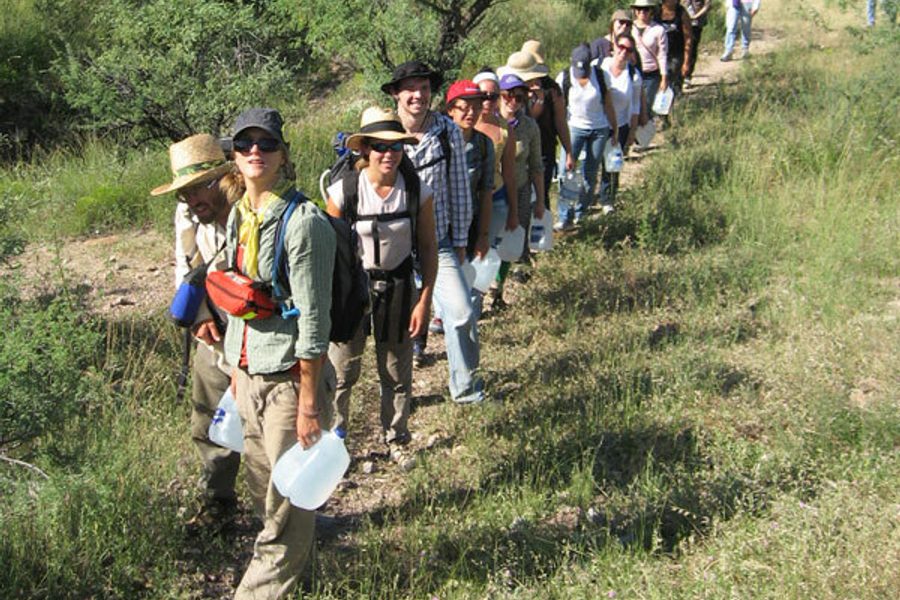Global Warming Accelerates
As sea levels rise faster than expected, political and social catastrophes loom.
Kari Lydersen

Sea levels are rising much faster than expected – perhaps by three feet or more by 2100, according to climate scientists at the American Association for the Advancement of Science (AAAS) annual meeting in Chicago in February.
Scientists there also announced that global warming is increasing at a greater rate than the U.N. Intergovernmental Panel on Climate Change (IPCC) predicted in its 2007 Fourth Assessment report.
For the last 15 years, sea levels, measured by satellite and by gauges in the ocean, rose twice as fast as in the past half century. And Stefan Rahmstorf, an oceanographer at the Potsdam Institute for Climate Change, notes that between 1961 and 2003, sea level has risen 50 percent faster than computer models predicted. Given these results, he said new modeling can’t yet be done “with any confidence.”
The sea level increase was brought on by melting ice sheets and glaciers, and the warming of the ocean, which causes water to expand. Because the effects of climate change on sea level have a long lag time, the expected rise by 2100 is merely the tip of the iceberg.
“In 100 years, we will only see a small fraction of the sea level rise we are setting in motion,” says Rahmstorf. Unless we immediately and significantly reduce emissions, he says, “We may commit our planet to a very long-term sea level rise measured in meters.”
Not only would a three-foot rise literally flood many cities, it would also have ripple effects that include food shortages, political conflicts and disease epidemics, as countries struggle to deal with millions of internally displaced people.
“Whether there will be environmental refugees is not a question of ‘if’ but ‘when, where and how we deal with it,’ ” says John Church, a scientist with the World Climate Research Programme.
In the Pliocene era 3 million years ago, the sea level was 131 feet higher than it is today. During the last Ice Age, 20,000 years ago, the level was about 394 feet lower than today – and the average temperature then was roughly 40 degrees Farenheit colder.
But modern coastal development and industrialization have occurred under a period of temporary sea level stability – which likely would not have been maintained long term, even without the anthropogenic effects of climate change accelerating sea level rise.
Not only are scientists concerned about the overall rise in sea level, but also the expected increase in storm surges. Hurricanes have increased in strength and duration, an effect scientists attribute to climate change. And the trend is expected to continue.
While impoverished people in developing countries will be most affected, developed countries will also suffer. In the United States, rising sea level and increasing storm surges mean major floods will become common in places they have never happened before, catching many people without flood insurance. Already few private insurers offer flood coverage because the payouts are so great. The U.S. government picks up the slack through a flood insurance program administered by the Federal Emergency Management Agency (FEMA). But if many more people suddenly need flood insurance, taxpayers may not be able to foot the bill.
In a worst-case scenario, melting ice sheets and glaciers in the Arctic region could cause severe chilling in the United States and Europe, because the influx of fresh water into the ocean could disrupt or slow thermohaline circulation. Also known as the “ocean conveyor belt,” this is the process whereby warm water from the tropics flows northward, moderating and warming the climate. When it hits the Arctic, it cools and sinks, then flows back toward the tropics. Some scientists fear extra fresh water from melting ice could prevent the water from sinking, and interrupt the cycle.
Finally, climate change is also making oceans more acidic. As the pH of the ocean drops, the calcium carbonate creatures – ranging from zooplankton to shellfish – will have a harder time making their shells. There have already been significant reductions or changes in calcium carbonate creatures because of acidification, with effects resonating up the food chain to marine mammals like walruses and even humans. If acidification continues, the oceans will likely be increasingly populated by jellyfish and other slimy, primordial creatures, scientists say.
As with other effects of climate change, acidification and sea level rise could trigger positive feedback loops that cause exponentially greater effects than otherwise predicted. An example of such a feedback loop would be the melting of Arctic permafrost, which releases massive quantities of methane, a powerful greenhouse gas that would accelerate warming even more.
“The warmer you get the greater the burden from these feedbacks,” says Christopher Field, an author of the IPCC assessments. “When you get a runaway greenhouse effect is when the oceans boil. We don’t expect that. But it’s certainly possible we could have a world very unattractive by the standards we live by today.”
Kari Lydersen is a Chicago-based journalist, author and assistant professor at Northwestern University, where she leads the investigative specialization at the Medill School of Journalism, Media, Integrated Marketing Communications. Her books include Mayor 1%: Rahm Emanuel and the Rise of Chicago’s 99%.









